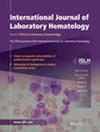Flow Cytometric Assessment of TRBC1 Expression for the Diagnosis of T-Cell Lymphoma: Clinical Utility and Pitfalls Related to T-Cell Clones of Uncertain Significance
Abstract
Background
T-cell receptor constant beta chain 1 (TRBC1) has emerged as a potential clonal marker for T-cell lymphoma. This study evaluated TRBC1 expression using flow cytometry in healthy individuals and various clinical specimens, assessing its clinical utility in the diagnosis of T-cell lymphomas.
Methods
Flow cytometric analysis was performed on peripheral blood specimens from 20 healthy individuals and 186 clinical specimens (116 bone marrow aspirates, 18 peripheral bloods, 52 body fluids) from 177 patients for the exclusion or differential diagnosis of T-cell lymphoma using a panel of nine monoclonal antibodies: CD45, CD3, CD4, CD8, CD56, CD2, CD5, CD7, and TRBC1.
Results
TRBC1 showed polytypic expression in healthy individuals with a median of 38.6% (range, 33.9%–46.1%) in CD4+ T cells and 26.3% (range, 10.9%–44.2%) in CD8+ T cells (p < 0.001). TRBC1 expression in non-T-cell lymphoma specimens was comparable to that in healthy peripheral blood, except for bone marrow, which showed slightly higher TRBC1 expression. All 20 T-cell lymphoma cases exhibited monotypic TRBC1 expression, with a predominance of TRBC1− (65%). Additionally, T-cell clones of uncertain significance (TCUS) were detected in 12.7% of non-T-cell lymphoma specimens, predominantly in CD8+ T cells and associated with cytopenic and reactive conditions.
Conclusions
This study demonstrates the clinical utility of flow cytometric TRBC1 assessment in diagnosing T-cell lymphomas, characterizing TRBC1 expression patterns, and identifying TCUS in a large cohort of specimens without T-cell lymphoma involvement across diverse clinical settings. Given the relatively frequent detection of TCUS, these findings underscore the importance of interpreting TRBC1 flow cytometry results within the appropriate clinical context.


 求助内容:
求助内容: 应助结果提醒方式:
应助结果提醒方式:


